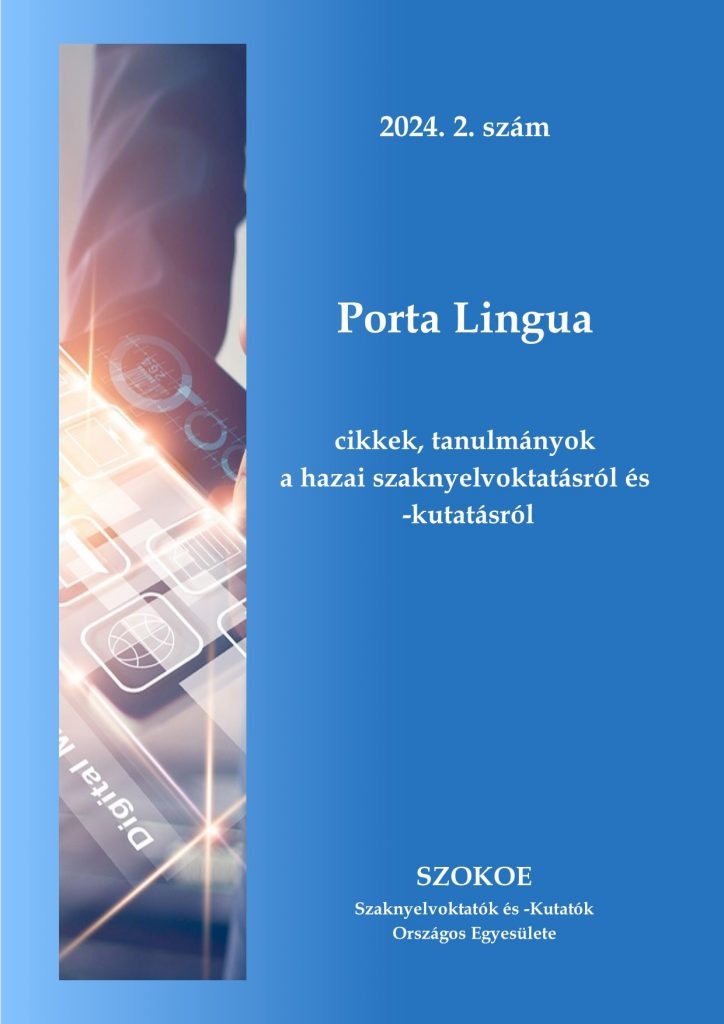Curriculum development in Spanish beginner classes using artificial intelligence
Abstract
A particular challenge in the teaching of specialised languages, especially for complete beginners, is to present all language-related examples in a professionally relevant, in our case medical context, for absolute beginners. Moreover, a problem that is often encountered in mixed mother tongue groups is that even the official audio material in textbooks is too fast and difficult to follow for those whose mother tongue and the target language are phonetically distant. Almost at the same time as ChatGPT and other artificial intelligence (AI)-driven systems were released, we experienced a proliferation of AI-based applications for educational purposes (Baditzné – Jakab, 2023), many of which can already be used successfully in language teaching and may provide a solution to the two problems mentioned above. They can be used to generate unique, contextualised, simplified sound samples, free of background noise and disfluency phenomena, based on professional materials instantly and efficiently translated, revised and adapted by AI in any language. In our study, we investigate to what extent the target language audio materials generated by AI differ from human samples, for example in segmental and prosodic terms, and to what extent they are suitable for supporting beginners’ courses in a specialized language. Our results show that among the three examined applications (Word, Speechify and Natural Reader), Word’s built-in text-to-speech synthesis function performed best, generating samples that are similar to natural speech in most respects.
References
Arnold, J. (2000): Seeing through Listening Comprehension Exam Anxiety. TESOL Quarterly , Winter, 2000, 34/4. (Winter, 2000). 777-786.
Baditzné Pálvölgyi, K. – Jakab, L. (2023): A mesterséges intelligencia alkalmazási lehetőségei a tanításban: kezdeti tapasztalatok és jó gyakorlatok. Anyanyelv-pedagógia 2023/3. 47–78. DOI: 10.21030/anyp.2023.3.3
Fogarasi, K. – Varga, É. K. (2022): Szaknyelvoktatás nulláról? Gyakorlatorientált szaknyelvi kurzusok a Semmelweis Egyetemen. Alkalmazott nyelvtudomány. 22/1. 22–39. DOI: http://dx.doi.org/10.18460/ANY.2022.1.002
Font-Rotchés, D. – Mateo Ruiz, M. (2011): Absolute interrogatives in Spanish: a new melodic pattern. In: Actas do VII congresso internacional da ABRALIN. Curitiba (Brasil). 1111–1125.
Harmer, J. (2007): The practice of English Language Teaching. Pearson Longman.
Karageorgakis, T. (2023): Best 100 AI apps for Teachers and the classroom. Educraft.tech. https://educraft.tech/best-100-ai-apps-for-teachers
Moreu, D. (Ed.) (2008): Medical Spanish Made Incredibly Easy! Wolters Kluwer: Lippincott Williams & Wilkins: Philadelphia
Nolte-Schlegel, – I. González Soler, J. J. (2004): Medical Dictionary/Diccionario de Medicina/Dicionário de termos médicos. Springer Science & Business Media: Berlin
Rahman, M. (2015): English for Specific Purposes (ESP): A Holistic Review. Universal Journal of Educational Research. 3/1. 24-31. DOI: 10.13189/ujer.2015.030104
Polat, M. – Erişti, B. (2022): The Effects of Authentic Video Materials on Foreign Language Listening Skill Development and Foreign Language Listening Anxiety at Different Levels of English Proficiency. International Journal of Contemporary Educational Research, 6/1. 135–154. DOI: https://doi.org/10.33200/ijcer.567863
Ríos, J. – Fernández Torres, J. (2004): McGraw – Hill’s Complete Medical Spanish. Practical Medical Spanish for Quick and Confident Communication. McGraw-Hill: New York
Rubin, J. (1994): A Review of Second Language Listening Comprehension Research. The Modern Language Journal. 78/2. 199–221. DOI: https://doi.org/10.1111/j.1540-4781.1994.tb02034.x
Unesco (2023): ChatGPT and artificial intelligence in higher education. Quick start guide. United Nations Educational, Scientific and Cultural Organization.
Scrivener, J. (2011). Learning Teaching. The essential Guide to English Language Teaching. Macmillan Books for Teachers: London.
Seco, M. (1999): Gramática esencial del español. Espasa Calpe: Madrid
Ur, P. (2012): A course in English Language Teaching. Oxford University Press.
Vogely, A. J. (1998). Listening Comprehension Anxiety: Students' Reported Sources and Solutions. Foreign Language Annals. 31/1. 67–80. DOI: https://doi.org/10.1111/j.1944-9720.1998.tb01333.x



